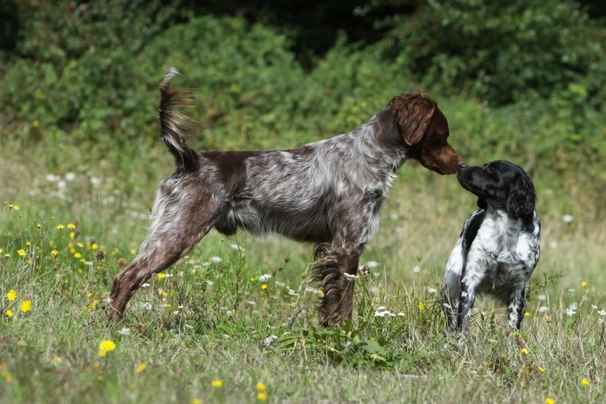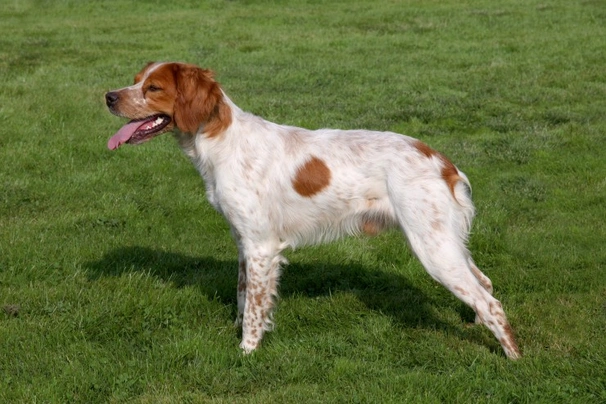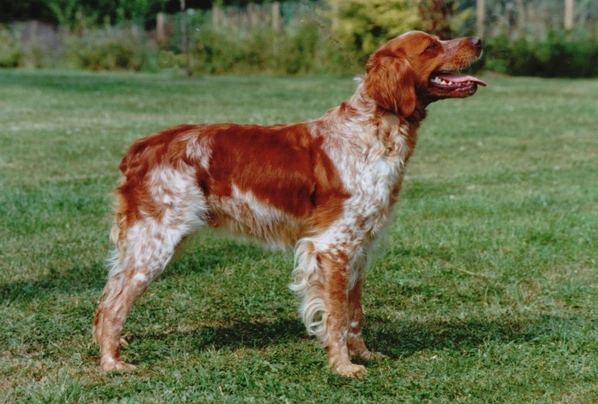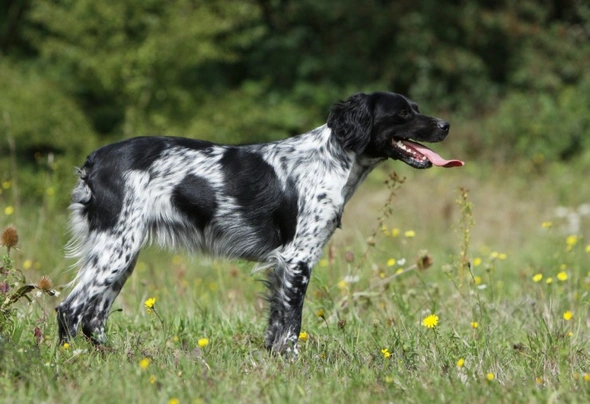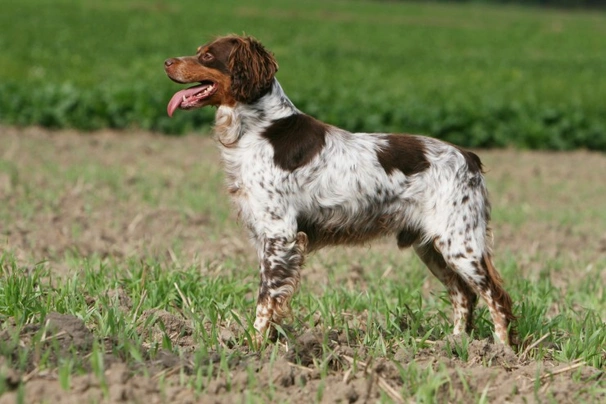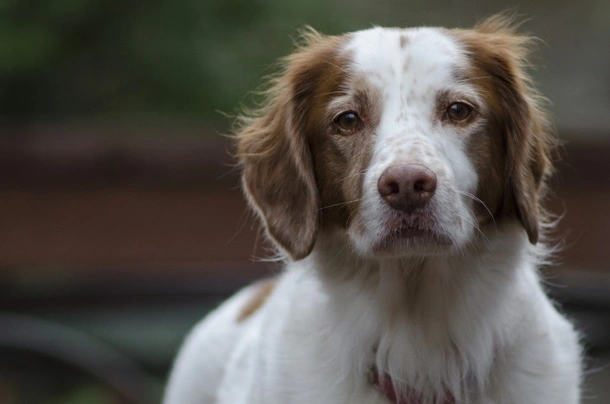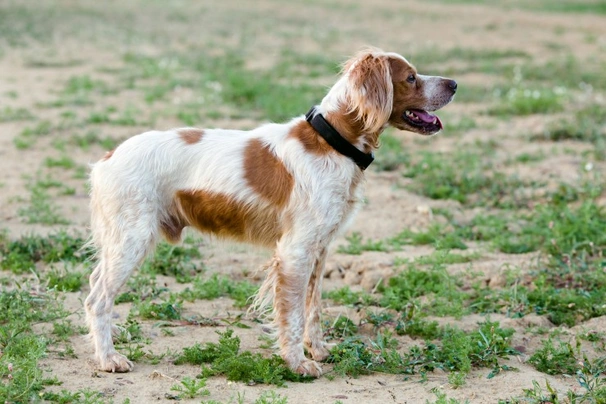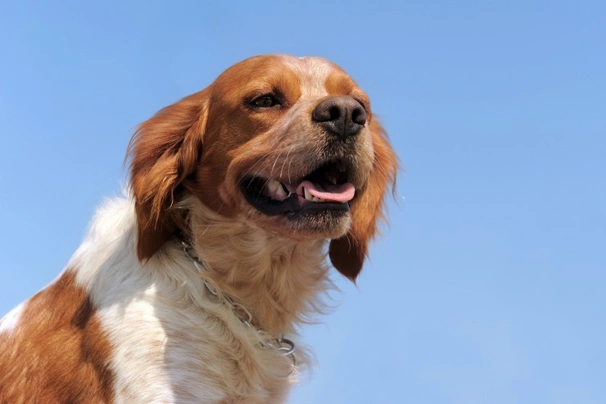Brittany Spaniel
Pros
Cons
Introduction of the Brittany Spaniel
The Brittany Spaniel is also known simply as a Brittany and as their name suggests they originate from France where they were bred as working dogs. They thrive on being kept busy and do not do well if left to their own devices for long periods of time. For decades the breed has been a popular working dog in their native France but are now becoming popular here in the UK thanks to their tremendous ability to Hunt Point and Retrieve.
The Brittany is quite a lightly built spaniel as compared to others of their type. They boast alert kind natures and are always eager to please which are just some of the reasons why they make such good working dogs in the field. Thanks to their willing personalities the Brittany is also a great companion or family pet especially in the right sort of environment and living with people who are familiar with the breed or this type of spaniel and who live active outdoor lives.
History of the Brittany Spaniel
The Brittany Spaniel was first bred in the Callac region of France. There is a statue of a French Cob horse that stands in the village of Callac which reputedly represents how a Brittany Spaniel should appear being strong and cobby just like the strong French horse. During the 1800's many English landed gentry spent time in France where they attended "shoots" which mainly saw them hunting partridge and snipe. When they went over to France they took their best "gundogs" with them which were mainly pointers and setters.
Very often the English hunters left their dogs behind when they returned to England so they would already be in France when the hunters returned the following year to attend upcoming shoots. This saw many French land owners crossing English dogs with their own native breeds which included a very spirited spaniel known as the Fougeres. The matings with English Pointers Gordon and English Setters was to produce the Brittany Spaniel.
These spaniels were so popular that by the 1900's breeding programmes were established with an end goal being to standardised the breed. Over time many Brittany Spaniels were to be Champions in their native France and as such British breeders used their prodigy to produce healthy puppies from renowned lines. The new hybrid spaniels were more skilled at scenting working that much better in the field. English Setters were then crossed with the Brittany in the 1900's with the end goal being to produce a taller dog. By the 1930's breeders began working towards producing a smaller more cobby-like spaniel and these dogs were to become a firm favourite in France having proved themselves to be highly skilled gundogs in the field.
The breed was finally recognised by the Kennel Club in 1997 with many spaniels now being exhibited in the showring as well as at field trials. Today the Brittany Spaniel has gained popularity not only in the field but in a home environment too thanks to their willing kind and reliable natures.
Interesting facts about the breed
- Is the Brittany Spaniel a vulnerable breed? No they are fast gaining a fanbase in the home environment although they have always been a popular gundog in the field
- The Brittany Spaniel has an interesting lineage in that many English gundog breeds were used to create them
- English hunters during the 1800’s would leave their dogs in France so they would be there the following shooting season
- Brittany Spaniels have always been highly prized for their hunt/point and retrieve abilities both in France and in England
- Traditionally a Brittany's tail was always docked but since the law banning the procedure came into effect in 2007 tail docking is now illegal with the exception being for some working breeds and if a dog suffers from some sort of health issue that requires their tails to be docked. The procedure must be agreed and authorised before being performed by a qualified vet
Appearance of the Brittany Spaniel
Height at the withers: Males 48 - 51 cm Females 47 - 50 cm
Average weight: Males 20 - 23 kg Females 20 - 23 kg
The Brittany Spaniel is a very light yet cobby looking dog that boasts an alert lively and intelligent expression about them. They are among the smallest of the gundog breeds and are renowned for their keen sense of smell. Their heads are slightly rounded and have a slightly defined median line and occiput. Stops are moderate and muzzles taper slightly with dogs having well-shaped and open nostrils.
Brittany Spaniels have very expressive brown to darker coloured eyes that match the colour of their coat. Eyes are oval and set obliquely. Ears are triangular with slightly rounded tips and they have slightly wavy hair on them. Dogs carry their ears high but they fall against their cheeks. The Brittany has a strong jaw with a perfect scissor bite where their upper teeth neatly overlap their lower ones.
Their necks are moderately long clean and set well into a dog's shoulders which slope moderately. Shoulders are muscular with a slight angulation and the top of their shoulder blades are set quite widely apart. Front legs are well muscled and straight. They have deep chests and briskets that reach right down to their elbows with well-rounded ribcages. Backs are rather short as are a dog's strong loins. Their topline slopes from the withers down to the croup which slopes slightly to where the tail is set. Hindquarters are strong and muscular with dogs boasting powerful thighs.
Their feet are round compact and tight with a little hair growing between each toe. Back feet are slightly longer than a dog's front feet. The Brittany Spaniel can be naturally tailless or they can have a "bob" tail which is set high and which dogs carry horizontally or a little lower.
When it comes to their coat the Brittany Spaniel boasts having a dense yet find coat that lies flat or can be slightly wavy. Front legs are slightly feathered with hind legs being well feathered right to a dog's mid-thigh. Accepted colours for Kennel Club registration are as follows:
- White
- Black & White Roan
- Black Tricolour
- Liver & White
- Liver Tricolour
- Orange & White
- Orange & White Roan
- Tricolour
Gait/movement
When a Brittany Spaniel moves they do so taking short brisk strides always keeping their topline level when on the move. They do not over extend their back legs when moving.
Faults
The Kennel Club frowns on any exaggerations or departures from the breed standard and would judge the faults on how much they affect a dog's overall health and wellbeing as well as their ability to perform.
Males should have both testicles fully descended into their scrotums and it is worth noting that a dog can be a little lighter or heavier as well as slightly taller or shorter than set out in the Kennel Club breed standard which is only given as a guideline.
Temperament of the Brittany Spaniel
It would be fair to say that the Brittany Spaniel is first and foremost a working/hunting dog and one that boasts a tremendous amount of stamina courage speed and character. The Brittany is an energetic and active dog by nature and likes nothing more than to be kept busy even in a home environment. With this said they make wonderful family pets and companion dogs for people who lead more active outdoor lives. They excel in field trials and are a firm favourite with people who like to compete both here in the UK and elsewhere in the world.
However a Brittany's training and education must start as early as possible and puppies have to be well socialised from a young age for them to grow up to be well-rounded obedient dogs. If these dogs are not well trained early in their lives they tend to run off if they get sight of anything in the distance. It's essential for a Brittany to be taught the "recall" command right from the word go and not to trust them too much off their leads anywhere near wildlife and livestock.
With this said the Brittany is a good choice for first time owners because of their strong desire to please. Being such intelligent dogs the Brittany is easy to train but they are not a good choice for people who lead more sedentary lives because these dogs need to be given masses of exercise and mental stimulation for them to be truly happy well-rounded and obedient dogs. In short owners need to have the time needed to dedicate to their dogs if they want to share a home with a Brittany Spaniel.
Are they a good choice for first time owners?
Brittany Spaniels are not the best choice for first time owners because they are the sort of dog that needs to be socialised handled and trained by people who are familiar with their specific needs when it comes to mental stimulation and daily physical exercise.
What about prey drive?
Although Brittany Spaniels are social by nature they have working and hunting in their lineage which are traits that are deeply embedded in a dog's psyche. As such they have a high prey drive which means care should always be taken when they are around smaller pets and animals they don't already know. Care should also be taken as to where and when a dog can run off the lead more especially when there is livestock and wildlife close by.
What about playfulness?
Brittany Spaniels are known to have a playful side to their natures and they love being involved in all sorts of interactive games as well as canine sports. They are especially good at agility flyball and tracking activities which are all things they thoroughly enjoy and which keeps these intelligent dogs nicely occupied both physically and mentally.
What about adaptability?
Brittany Spaniels are primarily working dogs and therefore are not suited to apartment living. They thrive in a home environment with people who lead very active outdoor lives with a canine companion at their side.
What about separation anxiety?
Brittany Spaniels form strong ties with their families and dogs are never very happy when they find themselves left on their own for longer periods of time. They are better suited to people who either work from home or in households where one person stays at home when everyone else is out so they are never alone for any length of time which could see a dog suffering from separation anxiety. This can lead to them being destructive around the home which is a dog's way of relieving any stress they are feeling and a way to keep themselves entertained.
What about excessive barking?
Brittany Spaniels are not known to be "barkers" and will only voice an opinion at meal times or to alert an owner when strangers are about or when something they don't like is going on in their environment.
Do Brittany Spaniels like water?
Brittany Spaniels are very at home in water and love swimming at any time of the year but more especially when the weather is very hot. However if anyone who owns a dog that does not like water should never force them to go in because it would just end up scaring them. With this said care should always be taken when walking a Brittany off the lead anywhere near more dangerous watercourses just in case a dog decides to leap in and then needs rescuing because they cannot get out of the water on their own.
Are Brittany Spaniels good watchdogs?
Brittany Spaniels are not natural watchdogs although this is not to say a dog would not be quick off the mark to let an owner know when there are strangers about although they would rarely do this aggressively preferring like most spaniel breeds to keep their distance and bark.
Intelligence / Trainability of the Brittany Spaniel
Brittany Spaniels are highly intelligent and in the right hands they learn new things extremely quickly. However this means they are also quick to pick up any bad habits too. Their training must start early and it must be fair and consistent to get the right sort of results. If a Brittany is allowed to dominate a situation they will which is something to be avoided at all costs.
Like all puppies Brittany Spaniels are incredibly cute when they are young and as such it is all too easy to spoil them when they first arrive in their new homes. However once a puppy is nicely settled new owners must start out as they mean to go on which means teaching a puppy the ground rules limits and boundaries so they understand what is expected of them. It also helps establish what is acceptable behaviour and what is not as well as a pecking order and who is the alpha dog in a household. The first commands a puppy should be taught are as follows:
- Come
- Sit
- Stay
- Heel
- Quiet
- Leave it
- Down
- Bed
Children and other
Brittany Spaniels are a good choice for people with families because they are very gentle dogs when they are around children. However like any other breed it's best for any interaction between children and dogs to be supervised to make sure playtime does not get too boisterous.
They are also known to get on well with other dogs especially if they have been well socialised as puppies. However due to their strong hunting instincts care must be taken when a Brittany Spaniel is around smaller pets and animals. With this said if they have grown up with a family cat in the household they will accept sharing their home with a feline friend but will chase off any other cats they come across.
Health of the Brittany Spaniel
The average life expectancy of a Brittany Spaniel is between 12 and 13 years when properly cared for and fed an appropriate good quality diet to suit their ages.
Like so many other breeds the Brittany is known to suffer from a few hereditary health issues which are worth knowing about if you are planning share your home with one of these active and good-looking dogs. The conditions that seem to affect the breed the most include the following:
- Hip dysplasia - test through the BVA/KC hip scoring scheme
- Hereditary deafness - BAER test through the Animal Health Trust (AHT)
- Elbow dysplasia - dogs should be tested
- Luxating patella
- Epilepsy
- Discoid Lupus Erythematosus (DLE)
- Multifocal retinal dysplasia
- Simple glaucoma
- Cataracts - affecting dogs in their later years
- Certain form of cancer
- Hypothyroidism
- Allergies
- Spinal muscular atrophy
- Ear problems
It is worth noting that the coefficient of inbreeding for Brittany Spaniels is 5.8% which means there is a large gene pool to draw from although breeders should always ensure they breed their dogs responsibly.
What about vaccinations?
Brittany puppies would have been given their initial vaccinations before being sold but it is up to their new owners to make sure they have their follow-up shots in a timely manner with the vaccination schedule for puppies being as follows:
- 10 -12 weeks old bearing in mind that a puppy would not have full protection straight away but would be fully protected 2 weeks after they have had their second vaccination
There has been a lot of discussion about the need for dogs to have boosters. As such it's best to talk to a vet before making a final decision on whether a dog should continue to have annual vaccinations which are known as boosters.
What about spaying and neutering?
A lot of vets these days recommend waiting until dogs are slightly older before spaying and neutering them which means they are more mature before undergoing the procedures. As such they advise neutering males and spaying females when they are between the ages of 6 to 9 months old and sometimes even when a dog is 12 months old.
Other vets recommend spaying and neutering dogs when they are 6 months old but never any earlier unless for medical reasons. With this said many breeds are different and it is always advisable to discuss things with a vet and then follow their advice on when a dog should be spayed or neutered.
What about obesity problems?
Like all breeds Brittany Spaniels can weight after they have been spayed or neutered and it's important to keep an eye on a dog's waistline just in case they do. If a dog starts to put on weight it's important to adjust their daily calorie intake and to up the amount of exercise they are given. Older dogs too are more prone to gaining weight and again it's essential they be fed and exercised accordingly because obesity can shorten a dog's life by several years. The reason being that it puts a lot of extra strain on a dog's internal organs including the heart which could prove fatal.
What about allergies?
Brittany Spaniels are prone to suffering from allergies and it's important for a dog to see a vet sooner rather than later if one flares up. Allergies can be notoriously hard to clear up and finding the triggers can be challenging. With this said a vet would be able to make a dog with an allergy more comfortable while they try to find out the triggers which could include the following:
- Certain dog foods that contain high levels of cereal and other grain-type fillers
- Airborne pollens
- Dust mites
- Environment
- Flea and tick bites
- Chemicals found in everyday household cleaning products
Participating in health schemes
All responsible Brittany Spaniel breeders would ensure that their stud dogs are tested for known hereditary and congenital health issues known to affect the breed by using the following schemes:
- BVA/KC hip scoring scheme
- Tested for elbow dysplasia
- BAER test for hereditary deafness through the Animal Health Trust (AHT) – dogs with a lot of white in their coats
What about breed specific breeding restrictions?
In October 2008 the Kennel Club decided that Brittany Spaniel puppies born with naturally bobbed tails could be registered which establishes which lines carry the gene responsible for them being tailless. All registrations must be accompanied by a letter from a qualified UK vet for them to be accepted by the Kennel Club.
What about Assured Breeder Requirements?
It is mandatory for all KC Assured Breeders to use the following test on their stud dogs and all other breeders are strongly advised to follow suit:
Caring for the Brittany Spaniel
As with any other breed Brittany Spaniels need to be groomed on a regular basis to make sure their coats and skin are kept in top condition. They also need to be given regular daily exercise to ensure they remain fit and healthy. On top of this dogs need to be fed good quality food that meets all their nutritional needs throughout their lives.
Caring for a Brittany Spaniel puppy
Like all puppies Brittany Spaniels are boisterous and full of life which means it's essential for homes and gardens to be puppy-proofed well in advance of their arrival. A responsible breeder would have well socialised their puppies which always leads to more outgoing confident and friendly dogs right from the word go. With this said any puppy is going to feel vulnerable when they leave their mother and littermates which must be taken into account. The longer a puppy can remain with their mother the better although it should never be for too long either.
It's best to pick a puppy up when people are going to be around for the first week or so which is the time needed for a puppy to settle in. Puppy-proofing the home and garden means putting away any tools and other implements that a boisterous puppy might injure themselves on. Electric wires and cables must be put out of their reach because puppies love chewing on things. Toxic plants should be removed from flowerbeds and the home too.
Puppies need to sleep a lot to grow and develop as they should which means setting up a quiet area that's not too out of the way means they can retreat to it when they want to nap and it's important not to disturb them when they are sleeping. It's also a good idea to keep "playtime" nice and calm inside the house and to have a more active "playtime" outside in the garden which means puppies quickly learn to be less boisterous when they are inside.
The documentation a breeder provides for a puppy must have all the details of their worming date and the product used as well as the information relating to their microchip. It is essential for puppies to be wormed again keeping to a schedule which is as follows:
- Puppies should be wormed at 6 months old
- They need to be wormed again when they are 8 months old
- Puppies should be wormed when they are 10 months old
- They need to be wormed when they are 12 months old
Things you'll need for your puppy
There are certain items that new owners need to already have in the home prior to bringing a new puppy home. It's often a good idea to restrict how much space a puppy plays in more especially when you can't keep an eye on what they get up to bearing in mind that puppies are often quite boisterous which means investing in puppy gates or a large enough playpen that allows a puppy the room to express themselves while keeping them safe too. The items needed are therefore as follows:
- Good quality puppy or baby gates to fit on doors
- A good well-made playpen that's large enough for a puppy to play in so they can really express themselves as puppies like to do
- Lots of well-made toys which must include good quality chews suitable for puppies to gnaw on bearing in mind that a puppy will start teething anything from when they are 3 to 8 months old
- Good quality feed and water bowls which ideally should be ceramic rather than plastic or metal
- A grooming glove
- A slicker brush or soft bristle brush
- Dog specific toothpaste and a toothbrush
- Scissors with rounded ends
- Nail clippers
- Puppy shampoo and conditioner which must be specifically formulated for use on dogs
- A well-made dog collar or harness
- A couple of strong dog leads
- A well-made dog bed that's not too small or too big
- A well-made dog crate for use in the car and in the home that's large enough for a puppy to move around in
- Baby blankets to put in your puppy's crate and in their beds for when they want to nap or go to sleep at night
Keeping the noise down
All puppies are sensitive to noise including Brittany puppies bearing in mind that like many other spaniel breeds they can be very sensitive by nature and stress out even when people shout or speak with raised voices. It's important to keep the noise levels down when a new puppy arrives in the home. TVs and music should not be played too loud which could end up stressing a small puppy out.
Keeping vet appointments
As previously mentioned Brittany puppies would have been given their first vaccinations by the breeders but they must have their follow up shots which is up to their new owners to organise. The vaccination schedule for puppies is as follows:
- 10 -12 weeks old bearing in mind that a puppy would not have full protection straight away but would only be fully protected 2 weeks after they have had their second vaccination
When it comes to boosters it's best to discuss these with a vet because there is a lot of debate about whether a dog really needs them after a certain time. However if a dog ever needed to go into kennels their vaccinations would need to be fully up to date.
What about older Brittany Spaniel when they reach their senior years?
Older Brittany Spaniels need a lot more in the way of special care because as they reach their golden years they are more at risk of developing certain health concerns. Physically a dog's muzzle may start to go grey but there will be other noticeable changes too which includes the following:
- Coats become coarser
- A loss of muscle tone
- Brittany Spaniels can either become overweight or underweight
- They have reduced strength and stamina
- Older dogs have difficulty regulating their body temperature
- They often develop arthritis
- Immune systems do not work as efficiently as they once did which means dogs are more susceptible to infections
Older dogs change mentally too which means their response time tends to be slower as such they develop the following:
- They respond less to external stimuli due to impaired vision or hearing
- They tend to be a little pickier about their food
- They have a lower pain threshold
- Become intolerant of any change
Often an older dog can feel disorientated
Living with a Brittany Spaniel in their golden years means taking on a few more responsibilities but these are easily managed and should include taking a look at their diet the amount of exercise they are given how often their dog beds need changing and keeping an eye on the condition of their teeth.
Older Brittany Spaniels need to be fed a good quality diet that meets their needs at this stage of their lives all the while keeping a close eye on a dog's weight. A rough feeding guide for older dogs is as follows bearing in mind they should be fed highly digestible food that does not contain any additives:
- Protein content should be anything from 14 – 21%
- Fat content should be less than 10%
- Fibre content should be less than 4%
- Calcium content should be 0.5 – 0.8%
- Phosphorous content should be 0.4 – 0.7%
- Sodium content should be 0.2 – 0.4%
Older dogs don't need to be given the same amount of daily exercise as a younger dog but they still need the right amount of physical activity to maintain muscle tone and to prevent a dog from putting on too much weight. All dogs need access to fresh clean water and this is especially true of older dogs when they reach their golden years because they are more at risk of developing kidney disorders.
Grooming of the Brittany Spaniel
A Brittany has a lovely glossy coat with lots of fine feathering around their ears on the backs of their legs and on their abdomens. However they don't have an undercoat which means they are quite low maintenance when it comes to keeping their coats looking great and in good condition. Their coats need to be brushed on a regular basis to prevent any matts and tangles from forming paying particular attention to a dog's feathering.
It might be necessary to trim any feathering that grows too long around a dog's ears on their legs and bellies which makes it less likely for tangles to form. It's also important to check a dog's ears on a regular basis and to clean them when necessary. If too much wax builds up in a dog's ears it can lead to a painful infection which can be hard to clear up. In short prevention is often easier than cure when it comes to ear infections.
Exercise of the Brittany Spaniel
Brittany Spaniels are active high-energy dogs and they need a minimum of 2 hours' exercise every day for them to be truly happy well-rounded dogs. A short walk in the morning would be alright but these dogs need a much longer and more interesting walk in the afternoon which should include playing lots of interactive games. As previously mentioned the Brittany is a highly intelligent character and without the right sort of mental stimulation a dog can quickly develop some unwanted behavioural issues which can be put down to sheer boredom.
If left to their own devices for even shorter periods of time the Brittany Spaniel can also suffer from separation anxiety which is why they are good choice for families where one person stays at home when everyone else is out of the house whereas they are not a good choice for people who spend most of the time away from home.
With this said young Brittany puppies should not be given too much exercise because their joints and bones are still growing and too much pressure on them could result in causing a dog a few problems later in their lives.
Feeding of the Brittany Spaniel
If you get a Brittany puppy from a breeder they would give you a feeding schedule and it's important to stick to the same routine feeding the same puppy food to avoid any tummy upsets. You can change a puppy's diet but this needs to be done very gradually always making sure they don't develop any digestive upsets and if they do it's best to put them back on their original diet and to discuss things with the vet before attempting to change it again.
Older dogs are not known to be fussy or finicky eaters but this does not mean you can feed them a lower quality diet. It's best to feed a mature dog twice a day once in the morning and then again in the evening making sure it's good quality food that meets all their nutritional requirements. It's also important that dogs be given the right amount of exercise so they burn off any excess calories or they might gain too much weight which can lead to all sorts of health issues. Obesity can shorten a dog's life by several years so it's important to keep an eye on their waistline from the word go.
Feeding guide for a Brittany Spaniel puppy
Puppies need to be fed a highly nutritious good quality diet for them to develop and grow as they should. As a rough guide a Brittany Spaniel puppy can be fed the following amounts every day making sure their meals are evenly spread out throughout the day and it's best to feed them 3 or 4 times a day:
- 2 months old - 191g to 244g depending on puppy's build
- 3 months old - 223g to 286g depending on puppy's build
- 4 months old - 239g to 305g depending on puppy's build
- 5 months old - 243g to 311g depending on puppy's build
- 6 months old - 243g to 311g depending on puppy's build
- 8 months old - 211g to 274g depending on puppy's build
- 10 months old - 177g to 232g depending on puppy's build
Once a puppy is 12 months old they can be fed adult dog food.
Feeding guide for an adult Brittany Spaniel
Once fully mature an adult Brittany Spaniel must be fed a good quality diet to ensure their continued good health. As a rough guide an adult Brittany can be fed the following amounts every day:
- Dogs weighing 20 kg can be fed 233g to 307g depending on activity
- Dogs weighing 23 kg can be fed 243g to 317g depending on activity
Brittany Spaniel price
If you are looking to buy a Brittany you would need to pay anything from £500 to over £700 for a well-bred pedigree puppy. The cost of insuring a male 3-year-old Brittany Spaniel in northern England would be £23.67 a month for basic cover but for a lifetime policy this would set you back £43.74 a month (quote as of January 2018). When insurance companies calculate a pet's premium they factor in several things which includes where you live in the UK and a dog's age and whether they have been neutered or spayed.
When it comes to food costs you need to buy the best quality food whether wet or dry to feed your dog throughout their lives making sure it suits the different stages of their lives. This would set you back between £40 - £50 a month. On top of this you would need to factor in veterinary costs if you want to share your home with a Brittany Spaniel and this includes their initial vaccinations their annual boosters the cost of neutering or spaying your dog when the time is right and their yearly health checks all of which quickly adds up to over a £1300 a year.
As a rough guide the average cost to keep and care for a Brittany Spaniel would be between £80 to £110 a month depending on the level of insurance cover you opt to buy for your dog but this does not include the initial cost of buying a well-bred healthy Kennel Club registered pedigree Brittany Spaniel puppy.
Buying advice
When visiting and buying any puppy or dog there are many important things to consider and questions to ask of the breeder/seller. You can read our generic puppy/dog advice here which includes making sure you see the puppy with its mother and to verify that the dog has been wormed and microchipped.
Brittany Spaniels are popular sporting dogs but the breed is also a popular family pet and companion both in the UK and elsewhere in the world which means that well-bred puppies can often command a lot of money. As such with Brittany Spaniels there is specific advice questions and protocols to follow when buying a puppy which are as follows:
- Beware of online scams and how to avoid them. You may see online and other adverts by scammers showing images of beautiful Brittany Spanielpuppies for sale at very low prices. However the sellers ask buyers for money up front before agreeing to deliver a puppy to a new home. Potential buyers should never buy a puppy unseen and should never pay a deposit or any other money online to a seller. You should always visit the pet at the sellers home to confirm they are genuine and make a note of their address.
- As previously touched upon Brittany Spaniels have always been a popular choice in the field but they have also gained a large fanbase in the home environment too. As such there are many amateur breeders/people who breed from a dam far too often so they can make a quick profit without caring for the welfare of the puppies their dam or the breed in general. Under Kennel Club rules a dam can only produce 4 litters and she must be between a certain age to do so. Anyone wishing to buy a Brittany puppy should think very carefully about who they purchase their puppy from and should always ask to see the relevant paperwork pertaining to a puppy's lineage their vaccinations and their microchipping.
- Prospective owners should be very careful when considering buying a Brittany Spaniel puppy from abroad and should always ensure they have been correctly imported into the UK and that they and their parent dogs have been tested for all the relevant hereditary and congenital conditions known to affect the breed
- Prospective owners should be careful when buying a Brittany puppy with a docked tail and should always make sure the procedure was carried out by a qualified vet with all the right permissions to avoid being liable for a hefty fine.

